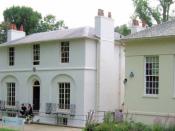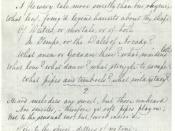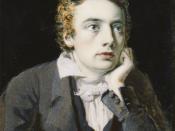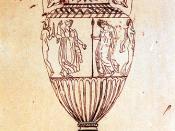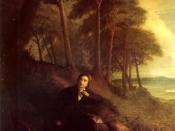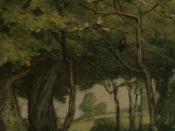The Romantic poet, John Keats, fuses the ideal with reality through his poetry. The ritual of the ÃÂEve of St. AgnesÃÂ is used to show Madeline her ideal husband. Sadly, reality does not allow Madeline to have her ideal husband. In the ÃÂOde on a Grecian Urn,ÃÂ Keats stresses the timeless beauty and purity of the urn to identify its ideal nature. He also mentions its true emptiness to manifest the reality of the urn. In the ÃÂOde to a Nightingale,ÃÂ Keats attempts to use the nightingale as a means of transcendence to a ÃÂbetter world.ÃÂ Yet this ÃÂbetter worldÃÂ is only temporary and one must always return to reality. These poems of John Keats are prime examples of the usage of the ideal and reality in Romantic poetry.
The ritual of the eve of St. Agnes is said to have caused a vision of a brideÃÂs husband.
The narrator mentions, ÃÂThey told her how, upon St. AgnesÃÂ Eve, Young virgins might have visions of delight, And soft adorings from their loves receive Upon the honeyÃÂd middle of the nightÃÂ (46-49). Porphyro uses this as an opportunity to solidify MadelineÃÂs choice in him. Porphyro will lean over so that Madeline will dream of and awake to him. Madeline will dream of Porphyro and in her dreams, he is the ideal husband she has been longing for. The narrator says, ÃÂHe playÃÂd an ancient ditty, long since mute, In Provence callÃÂd, ÃÂLa belle dame sans mercy:ÃÂ Close to her ear touching the melody;ÃÂWherewith disturbÃÂd, she utterÃÂd a soft moan: He ceasedÃÂshe panted quickÃÂand suddenly Her blue affrayed eyes wide open shoneÃÂ ÃÂ(291-294). The soft moan and pants indicate the pleasure of MadelineÃÂs dream of Porphyro. It seems as though Madeline has seen her ideal husband in her vision.
Porphyro prepared for this manipulation very well and it seemed to have caused success. The narrator says, ÃÂIn blanched linen, smooth, and lavenderÃÂd, While he from forth the closet brought a heap Of candied apple, quince, and plum, and gourd; With jellies soother than the creamy curd, And lucent syrops, tinct with cinnamonÃÂ ÃÂ (263-267). This indicated his preparation for this event. Yet by Porphyro interfering in the ritual, the idealness of the ritual itself is negated. The ritual is meant to supernaturally allow the virgin bride to have a vision of their true husband. Therefore, Porphyro forces ÃÂrealityÃÂ into MadelineÃÂs ideal dream. Also Madeline comes to realize that the ideal cannot be reality. The narrator mentions, ÃÂHer eyes were open, but she still beheld, Now wide awake, the vision of her sleep: There was a painful change, that nigh expellÃÂd The blisses of her dream so pure and deep At which fair Madeline began to weepÃÂ ÃÂ (298-302). Madeline awakes to Porphyro and is somewhat disappointed. She looks at him and begins to weep because she comes to a realization. This realization is that the real Porphyro cannot compare to her ideal Porphyro.
The urn, in the ÃÂOde on a Grecian Urn,ÃÂ is portrayed as an ideal and almost supernatural object. He uses vivid imagery and portrays it as a timeless image of classical antiquity. The narrator mentions, ÃÂHeard melodies are sweet, but those unheard Are sweeter; therefore, ye soft pipes, play on; Not to the sensual ear, but, more endearÃÂdÃÂ ÃÂ (11-13). He makes it seem as though the urn is perfect. He also depicts it as of timeless beauty and purity. Keats narrates, ÃÂThou still unravishÃÂd bride of quietness, Thou foster-child of silence and slow timeÃÂ ÃÂ (1-2). The ÃÂunravishÃÂdÃÂ bride is supposed to symbolize the purity or virginity of the urn. Referring to the urn as a ÃÂfoster-child,ÃÂ personifies the urn and attempts to compare it to a human. This reference is used to imply that the urn is not of other urns, yet it was cared for by humans.
This idealistic tone quickly changes when the speaker realizes the actual emptiness of the urn. The speaker praises the melancholy image on the urn, yet realizes that art leaves questions unanswered. The tone begins as pleasant praise to violent skepticism. The narrator says, ÃÂWhat leaf fringed legend haunts about thy shapeÃÂ (5). Since art is 'still,' it is not dynamic or amendable to being able to answer questions. The narrator also mentions, ÃÂWhat mad pursuit? What struggle to escape? What pipes and timbrels? What wild ecstasyÃÂ (9-10)? The narrator finally comprehends that art does not display the complete narrative; art is just the representation of a singular moment. A singular moment, which does not tell the emotions and background that are necessary in fully understanding.
The ÃÂOde to a NightingaleÃÂ explores the sufferings of mortal life and ways of escape including alcohol, imagination and poetry, and death. The nightingale represents transcendence to a better world and its song is the means by which the narrator reaches this state. The narrator says, ÃÂWith beaded bubbles winking at the brim, And purple-stained mouth; That I might drink, and leave the world unseen, And with thee fade away into the forest dimÃÂ ÃÂ (17-20). The narrator wants to escape his pains through alcohol. He then wants to transcend with the nightingale. He narrates, ÃÂAway! away! for I will fly to thee, Not charioted by Bacchus and his pards, But on the viewless wings of Poesy, Though the dull brain perplexes and retardsÃÂ ÃÂ (31-34). He longs to transcend with to the nightingale and to be in a ÃÂbetter world.ÃÂSadly, the narrator returns to reality and comes to a realization about the nightingale. This realization seems to have been prompted by the word ÃÂforlorn.ÃÂ The speaker says, ÃÂThe same that oft-times hath CharmÃÂd magic casements, opening on the foam Of perilous seas, in faery lands forlornÃÂ (68-70). This word leads to the narratorÃÂs realization. He then says, ÃÂForlorn! the very word is like a bell To toil me back from thee to my sole self! Adieu! the fancy cannot cheat so well As she is famÃÂd to do, deceiving elfÃÂ (71-74). He realizes the nightingale has deceived him by convincing him he can escape into the ideal world. He realizes that this world is only temporary and he must always return to reality.
In conclusion, John Keats brilliantly fuses the ideal and reality in order to intensify his Romantic poetry. The ÃÂEve of St. Agnes,ÃÂ the ÃÂOde on a Grecian Urn,ÃÂ and the ÃÂOde to a NightingaleÃÂ are prime examples of his use of the ideal and reality. There is a recurring theme of the ideal and how it always must return to reality.
Bibliography"Eve of St. Agnes" by John Keats"Ode on a Grecian Urn" by John Keats"Ode to a Nightingale" by John Keats
